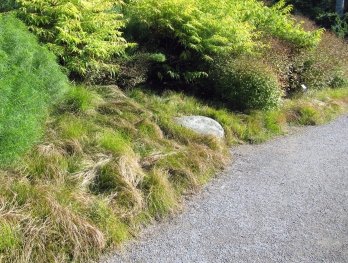
Turfgrass and ornamental grass share the same last name, but they are very different plants. What's important is that ornamental grasses and their cousins, the sedges, are great problem-solvers, capable of filling niches where turfgrass is faint of heart.
Consider the differences:
1. Turfgrass varieties become a lawn by spreading shallow roots. Ornamental grasses, by contrast, almost universally grow deeper roots in a “bunching” form.
2. Where turfgrass varieties are selected for their ability to handle mowing and foot traffic, ornamental grasses are selected for their height and color.
3. Turfgrass species in our area are “cool season” varieties, plants that look best during spring and fall. Many ornamental grasses, in contrast, are warm-season metabolizers that grow fastest and look best when the weather is hot and dry. Even cool-season ornamental grasses withstand hot, dry weather better than most turfgrass, possibly because they are deeper-rooted. These roots can find deep groundwater sources as the plant matures.
4. Deep roots also help bunching grasses survive the rigors of sloping landscapes, where turfgrass often struggles. Again, turfgrass roots are usually only six to twelve inches deep.
5. As for their ecological impact, most native bunching grasses provide both food and protective cover for birds, insects, and wildlife. Turfgrass offers little value to wildlife, partly mowing takes away the seed heads and the height is too low to provide safe cover for most creatures.
Ready to cover ground with ornamental grasses? Let’s go. See my article at The Day/Zip06. If you are having trouble with the links, please download the PDF below.
| Attachment | Size |
|---|---|
| 169.48 KB | |
| 125.16 KB |
